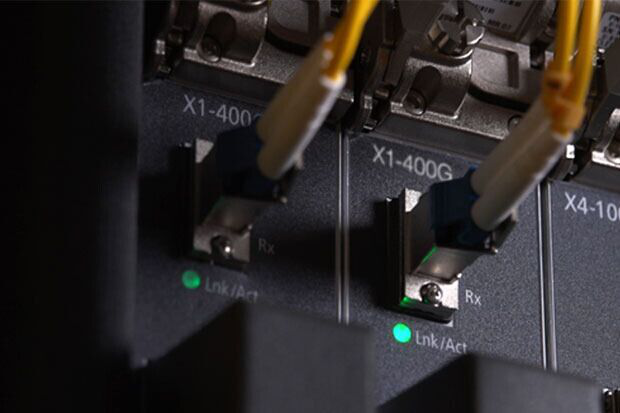Network carriers continue to face the bandwidth and capacity challenges in metro, regional and long-haul networks, as the traffic grows driven by more and more video streaming and proliferation of cloud computing, internet of things, data centers and mobile data delivery, etc. According to the prediction of IEEE (Institute of Electrical and Electronics Engineers), the wold’s largest technician professional organization dedicated to advancing technology for the benefit of humanity, the network traffic would increase one hundred times by 2020. As the main carrier of network traffic, the optical transmission network has to expand its capacity and flexibility to meet customers’ demands. Thus, 400 GbE solutions will be needed to support this increasing demands.

With the business needs for short and long term bandwidth requirements, the IEEE Industry Connections Higher Speed Ethernet Consensus group met in 2012 September and chose 400 GbE as the next generation goal. In March 2013, IEEE 802.3 formed 400 Gb/s Ethernet Study Group working on the 400 Gbit/s generation standard and later published its results on March 27th, 2014. Subsequently, the IEEE 802.3bs Task Force started working to provide physical layer specifications for several link distances, which are expected to be published in December 2017.
According to IEEE 802.3 Industry Connections Ethernet Bandwidth Assessment reports, the objectives of 400G solutions are as follows:
- Support full-duplex operation only
- Preserve the Ethernet frame format utilizing the Ethernet MAC
- Preserve minimum and maximum Frame Size of current Ethernet standard
- Provide appropriate support for OTN (Optical Transport Network)
- Specify optional EEE (Energy Efficient Ethernet) capability for 400Gb/s PHYs
- Support optional 400 Gb/s Attachment Unit Interfaces for chip-to-chip and chip-to-module applications
At this time, 400G modulation has not yet been defined, but the industry has launched many options that enable much higher data rates and improved compensation for optical impairments. Among these modulation format options for 400G super-channels, three of them are commonly used: 100GPDM-QPSK, 200GPDM-16QAM, and 400GPDM-32QAM.
Currently, the widely deployed 100G long-haul optical systems are all based on PDM-QPSK (Polarization Division Multiplexed Quadrature Phase-Shift keying). This modulation is mature and widely used in 100G networks, which provides a good solution for 400G systems by combing four bands of 100G PDM-QPSK. 100GPDM-QPSK modulation is available with long distance application but it has low spectral efficiency and high power consumption.
QAM (Quadrature Amplitude Modulation) is one of higher-level implementation options. Typically, there are two ways to achieve 400G solutions with QAM. One of them is 200GPDM-16QAM that employs 2 sub-channels at 200 Gb/s each, with PDM-16QAM modulation at 32 Gbaud, and Nyquist channel spacing (32 GHz). This modulation can greatly increase spectral efficiency by 168% with higher system integration, lower volume and little power consumption. It is a perfect solution for short distance, but limited in remote distance.
The other is 400GPDM-32QAM using single carrier 400Gb/s system with baud rate of 61. This modulation can enhance spectral efficiency by 300% and has high system integration. It seems this solution with the highest spectral efficiency is the best scheme among the three modulations. However, the solution is not promising in long distance transmission because of its complex technology, high cost and shorter span.
400G solutions are most probably the next phase in the 100G core era. This is encouraging because 400G transport may inherit some advantages from recent 100G efforts. However, we have to notice that there are huge uncertainties that remain in 400G marketing and product design strategies. These uncertainties are of three varieties.
The first uncertainty is associated with understanding how much the current enthusiasm over 400G transport trials can translate into actual deployment. That’s to say, the technology needs to be invented for a shift to a transport network infrastructure operating with 100G pipes can be reused to some extent at 400G.
Another is the relative absence of agreed standards for 400G public network transport. Although IEEE has made great efforts to do precisely this in its report, the issue of which application layer environment available with 400G solutions is more complicate in reality.
The final uncertainty turns out the most worrisome: how 400G transport platforms can respond to a rapidly evolving service environment. As the ability to create low-bandwidth voice traffic was always in the hands of millions of individuals, it is very difficult for 400G transport equipment to respond to the changeable service environment.
Although 100 Gigabit Ethernet is just at the beginning of widespread uptake, there is already plenty of talk in the market about the need for 400GbE in the enterprise. However, 400GbE is not yet mature and is still under the testing phrase in the laboratory and the network. How to improve the advanced spectral shaping and multiplexing technology? And can we break the limits of Shannon Theory to adapt the Flex-grid technology with a variety of spectral bandwidth? These problems are required to be solved to better service the 400 GbE solutions.




